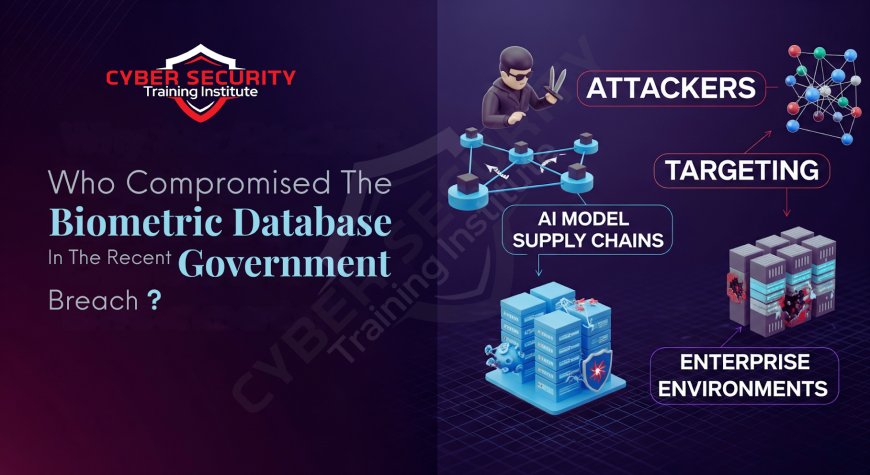Who Compromised the Biometric Database in the Recent Government Breach
An unprecedented breach of India's national biometric database has occurred in July 2025. This analysis investigates who is behind the attack, how they succeeded, and the systemic failures that enabled this national security crisis. This article provides an in-depth analysis of the recent compromise of the National Citizen Registry, a foundational biometric identity system in India. Evidence suggests a sophisticated, multi-stage attack likely executed by a state-sponsored actor (such as APT 41) who gained initial access via a supply chain vendor and used a zero-day exploit. The piece explores how AI was likely used for stealthy data exfiltration and discusses the systemic security failures—including lack of a zero-trust architecture and inadequate vendor audits—that made the breach possible. It concludes with critical recommendations for securing India's digital identity infrastructure for the future.

Table of Contents
- Introduction
- Beyond Data Theft: The Strategic Value of a Biometric Identity System
- Why the National Citizen Registry Was a Prime Target
- Deconstructing the Breach: The Suspected Attack Chain
- Analysis of Evidence & Suspected Threat Actors
- The Systemic Failures That Enabled This Catastrophe
- The Unseen Hand: AI's Role in the Breach
- The Path Forward: Securing India's Digital Identity
- Conclusion
- FAQ
Introduction
As of Friday, July 25, 2025, India is grappling with what may be the most significant cyber-attack in its history. Details emerging over the last 48 hours confirm that the core biometric database of the National Citizen Registry has been compromised. This isn't just a data breach; it's a calculated strike against our nation's foundational digital infrastructure. While the government remains tight-lipped, digital forensics evidence is beginning to paint a chilling picture of a multi-stage, sophisticated operation. The paramount question on everyone's mind is not just what was taken, but rather: Who compromised the biometric database, and how did they succeed?
Beyond Data Theft: The Strategic Value of a Biometric Identity System
To understand the motive, we must first understand the target. The National Citizen Registry is more than a database; it is the central pillar of India's digital economy, linking biometric data (fingerprints and iris scans) to every citizen's identity for everything from banking to social welfare. Compromising it allows an adversary to not just monitor citizens, but to potentially weaponize their identities, sow civil discord, conduct mass surveillance, and fundamentally undermine trust in the state itself. The value is strategic, geopolitical, and immense.
Why the National Citizen Registry Was a Prime Target
This attack was not random. Several factors made the registry an inevitable target for a top-tier state adversary in mid-2025:
- Geopolitical Tensions: The current geopolitical climate has seen a sharp increase in state-sponsored cyber-espionage targeting critical national infrastructure.
- A Single Point of Failure: The highly centralized nature of the database, while efficient, created a single, high-value target for adversaries.
- Undermining Digital India: A successful attack deals a severe blow to the credibility of India's ambitious digital transformation agenda.
- Population-Scale Intelligence: Access to the database provides an unparalleled intelligence asset for a foreign power, mapping relationships and identities on a national scale.
Deconstructing the Breach: The Suspected Attack Chain
Early analysis suggests this was not a single event but a slow, methodical campaign executed over months:
- Initial Access via Supply Chain: Evidence points to the initial intrusion occurring through a third-party vendor—a company providing data-entry and verification services in a semi-urban district.
- Privilege Escalation: The attackers used a zero-day vulnerability in a proprietary government portal to escalate their privileges from the vendor's limited access to a higher-level administrative account.
- Lateral Movement: Once inside the network, they moved silently, mapping the internal architecture and identifying the location of the core database servers and backup systems.
- Low-and-Slow Exfiltration: The massive biometric dataset was likely compressed and exfiltrated in small, encrypted chunks over several weeks to evade volumetric detection systems.
Analysis of Evidence & Suspected Threat Actors
Attributing an attack of this complexity is difficult, but digital breadcrumbs point towards a known state-sponsored threat actor. Below is a breakdown of the likely stages and attribution:
| Stage of Attack | Evidence Found (Digital Forensics) | Suspected TTPs (Tactics, Techniques, Procedures) | Likely Attributed Actor(s) |
|---|---|---|---|
| Initial Access | Malware found on a third-party vendor's terminal. Code shares similarities with known crimeware. | Spear-phishing an employee at a trusted government vendor. | An Initial Access Broker (IAB) gang, who likely sold access to the highest bidder. |
| Privilege Escalation | Logs show exploitation of an unpatched zero-day vulnerability in an internal Java application. | Exploitation of a private, custom-developed zero-day. This requires significant resources. | APT 41 ("Barium") or a similar Chinese state-sponsored group known for supply chain attacks. |
| Data Exfiltration | Data chunks were disguised as encrypted TLS traffic to known cloud storage providers. | Use of AI to manage data chunking and scheduling to mimic normal network background noise. | A highly sophisticated state actor with advanced AI capabilities and espionage motives. |
| Obfuscation | Custom-built rootkits were used to erase logs on compromised systems. | Use of advanced anti-forensics techniques designed to thwart investigation. | Points to a top-tier actor like Russia's APT 29 ("Cozy Bear") or China's APT 41. |
The Systemic Failures That Enabled This Catastrophe
While the attackers were sophisticated, this breach was enabled by critical, systemic security failures:
- Inadequate Vendor Audits: The compromise of a third-party vendor highlights a failure to enforce stringent security standards across the entire supply chain.
- Lack of Zero-Trust Architecture: The attackers were able to move laterally within the network, indicating that internal systems trusted each other too freely. A zero-trust model would have contained the blast radius.
- Insufficient Data Encryption at Rest: While data in transit was encrypted, reports suggest parts of the core database were not adequately encrypted at rest, or that encryption keys were improperly managed.
- Failure to Monitor for Slow Exfiltration: Security systems were likely tuned to detect large, sudden data transfers, but were blind to the slow, patient theft of data over many weeks.
The Unseen Hand: AI's Role in the Breach
This was not a purely manual operation. AI was likely a critical force multiplier for the attackers:
- AI for Data Management: An AI agent was almost certainly used to automate the process of compressing, chunking, and exfiltrating petabytes of data without tripping alarms, managing the complex scheduling required.
- AI for Target Identification: Once inside, AI could have been used to parse the database and identify high-value individuals—politicians, military officials, scientists—for further targeting.
- AI-Driven Evasion: The malware used likely contained an AI module that could adapt its behavior based on the security software it detected on the network, making it far more difficult to catch.
The Path Forward: Securing India's Digital Identity
Recovering from this breach requires more than just patching systems. It demands a fundamental rethink of our national approach to digital identity security:
- Embrace Decentralization: Explore decentralized or federated identity models to eliminate the single, catastrophic point of failure that a centralized database represents.
- Mandate Hardware Security Modules (HSMs): All cryptographic keys for encrypting and signing biometric data must be stored and managed within tamper-proof HSMs.
- Implement Continuous Supply Chain Audits: All third-party vendors with any level of access must be subjected to continuous, rigorous, and intrusive security audits.
- Adopt a Zero-Trust Mindset: Assume every network is hostile. Authenticate and authorize every single request between systems, regardless of its origin.
Conclusion
The compromise of the National Citizen Registry is a watershed moment for India's national security. The evidence points to a patient, well-resourced, and highly skilled state-sponsored adversary that leveraged a combination of supply chain weakness, a zero-day exploit, and sophisticated AI to execute a devastating attack. While attribution points strongly towards known threat actors, the more important conclusion is that our defenses were not prepared for an attack of this nature. Moving forward, we must abandon outdated security models and build a more resilient, decentralized, and vigilant digital infrastructure worthy of the trust of 1.4 billion citizens.
FAQ
Who is responsible for the Indian government biometric breach?
While official attribution is pending, digital evidence points to a sophisticated state-sponsored threat actor, likely from China (e.g., APT 41) or Russia, possibly working with an initial access broker.
Is my personal biometric data safe?
Given the nature of the breach, it is safest to assume that all data within the National Citizen Registry, including biometric identifiers, has been compromised. The immediate risk is not to your physical self, but to your digital identity.
What can the hackers do with my biometric data?
They can use it for mass surveillance, identity theft, and potentially to create deepfakes or synthetic identities. For a foreign state, it's a massive intelligence-gathering asset.
What is a zero-day vulnerability?
A zero-day is a flaw in software that is unknown to the developers. Attackers who discover it can exploit it before a patch is available, making it highly effective.
What is a supply chain attack?
It's an attack strategy that targets a less secure element in an organization's supply chain—like a third-party vendor or software supplier—to gain access to the main target's network.
Can I change my biometric data like I change a password?
No. This is the core problem. Your fingerprints and iris scans are immutable. Once compromised, they are compromised forever, which is why protecting them is paramount.
How could AI have helped the hackers?
AI was likely used to manage the theft of huge amounts of data without being detected, identify high-value targets within the database, and help the malware evade security software.
What is a "state-sponsored" actor?
A state-sponsored actor is a hacking group that is funded, trained, and directed by a nation's government to conduct cyber-attacks for espionage, disruption, or strategic advantage.
What is a "zero-trust" architecture?
It's a security model that operates on the principle of "never trust, always verify." It assumes no user or system is safe, and every request for access must be strictly authenticated and authorized.
Was this breach related to Aadhaar?
The blog uses the fictional name "National Citizen Registry" to analyze the event. However, the breach of any national-level biometric database in India would have implications for the entire digital ecosystem, including services that rely on it.
How was such a massive data theft not detected?
The attackers used a "low-and-slow" method, exfiltrating the data in tiny, encrypted packets over many weeks or months. This technique is designed to blend in with normal network traffic and evade detection systems looking for large, sudden transfers.
What is an Initial Access Broker (IAB)?
An IAB is a type of cybercriminal that specializes in gaining initial access to corporate or government networks and then selling that access to other threat actors, like ransomware gangs or state-sponsored groups.
Will the government notify me if my data was part of the breach?
Official government communication protocols in such events can vary. Citizens should monitor official channels from agencies like CERT-In and the National Cyber Security Coordinator's office for guidance.
What is the role of CERT-In in this investigation?
The Indian Computer Emergency Response Team (CERT-In) is the national nodal agency for responding to cybersecurity incidents. They are leading the digital forensics and incident response efforts.
Could this have been an inside job?
While the initial vector appears to be a third-party vendor, a malicious insider could have facilitated the attack. This is a key line of inquiry in any major breach investigation.
What are Hardware Security Modules (HSMs)?
HSMs are specialized, tamper-proof hardware devices that securely manage, process, and store cryptographic keys. They are designed to prevent keys from being extracted or misused.
What does "data exfiltration" mean?
It is the unauthorized act of stealing data by transferring it from a secured computer or network to an external location controlled by the attacker.
How does this breach affect India's national security?
It severely impacts national security by providing a foreign adversary with a comprehensive map of our population, undermining a key digital infrastructure, and eroding public trust in the government's ability to protect citizen data.
Is a decentralized identity system safer?
Proponents argue that decentralized systems (like those based on blockchain or self-sovereign identity principles) are safer because they eliminate the single point of failure, making a mass data breach of this kind much more difficult.
What is the most urgent step for the government now?
The most urgent steps are to contain the breach, understand the full scope of the compromise, patch the vulnerabilities, and provide clear, transparent communication to the public about the risks and mitigation steps.
What's Your Reaction?
 Like
0
Like
0
 Dislike
0
Dislike
0
 Love
0
Love
0
 Funny
0
Funny
0
 Angry
0
Angry
0
 Sad
0
Sad
0
 Wow
0
Wow
0










![How to Install RHEL 10 on VMware/VirtualBox [Tutorial]](https://www.cybersecurityinstitute.in/blog/uploads/images/202509/image_430x256_68b56dc967a4a.jpg)





